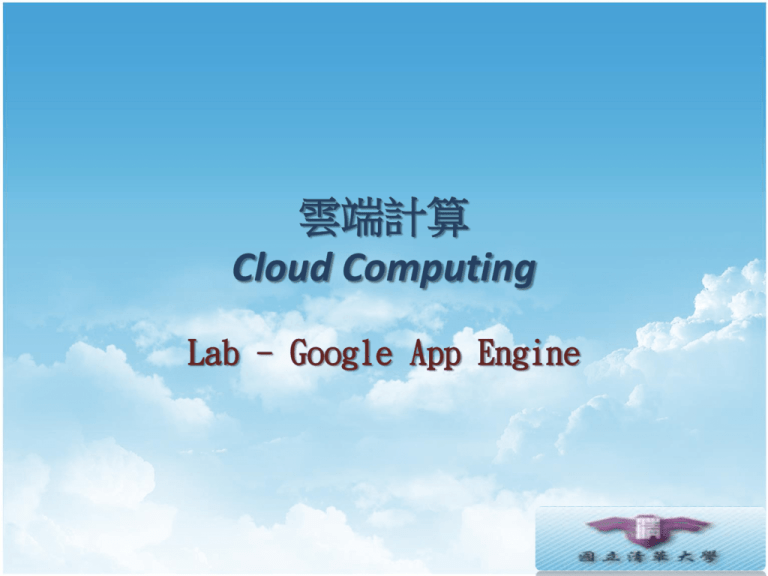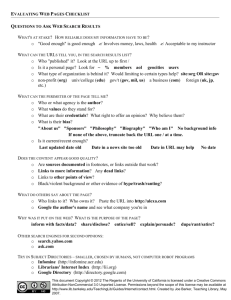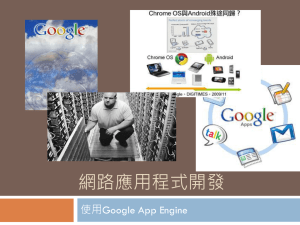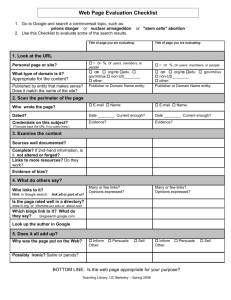Google App Engine
advertisement

雲端計算
Cloud Computing
Lab - Google App Engine
Agenda
• Introduction
What is Google App Engine?
• Installation
How to start?
• Lab
What do we do?
• API
How to complete it?
Overview
Concept
INTRODUCTION
Google App Engine
• Google app engine (GAE) is platform as a service
(PaaS) in cloud-computation system.
• In April 2008, it was first released as a beta
version with Python as a programming language.
• Currently, the support programming language are
Python 2.5 and Java 6.
They claim
• Google App Engine enables you to build and host
web apps on the same systems that power Google
applications.
- Google
• Google App Engine is a platform for developing
and hosting web application in Google-managed
data center.
- Wikipedia
Goal of GAE
• GAE lets you run your web applications on
Google’s infrastructure.
• GAE designs goals:
Make the system easy to use.
Make it easy to scale.
Make it free to get started.
• GAE also provides a App Engine SDK that support
programmers developing in their computer.
And more
• You do not need to purchase, maintain, and
manage all of infrastructures.
• You just upload your application, and it is ready to
serve your users.
• There are no set-up costs and recurring fees, you
only pay for what you use.
Benefits
• GAE provides an infrastructure for running web apps
It means that we're focused, specifically on web applications.
Making web services easy to run, easy to deploy, and easy to
scale.
• GAE do not run arbitrary compute jobs, also do not
give a raw virtual machine.
• Instead, GAE provide a way for you to package up your
code, specify how you want it to run in response to
requests, and then we run and serve it for you.
More benefits
Need not to purchase
Hosting service
Need not to build data center
Free domain name service
Scalability
Pay as you go
Need not to manage
Easy to initial
Free your mind
Overview
Concept
INTRODUCTION
Sketch
HTTP / HTTPS
URL fetch or E-mail
Web page
Web interface
Browser
Sandbox
Request
transactions
Runtime
environment
Result
Response
Datastore
Memcache
Schedule routine
More
services
Static Storage
Sketch
HTTP / HTTPS
URL fetch or E-mail
Web page
Web interface
Browser
Sandbox
Request
transactions
Runtime
environment
Result
Response
Datastore
Memcache
Schedule routine
More
services
Static Storage
Sandbox
• Sandbox is a security
mechanism for
separating running
programs and often
used to execute
untested programs.
• Applications run in
sandbox that provides
limited access to the
underlying operating
system.
Sandbox
• Sandbox is independent of the hardware,
operating system and physical location of the web
server.
Access other computer only on the Internet through the
provided URL fetch.
Other computer can only connect to GAE application by
making HTTP (or HTTPS) requests.
• Application also cannot write to the file system,
only can read which upload with application code.
App must use the GAE datastore that persists between
requests.
Runtime Environment
• GAE provides two runtime environment, Python
and Java, which can be used to design web services.
• GAE includes rich APIs and tools for web
application development.
• In general, GAE provides standard library, like JRE
standard library or Python 2.X standard library.
Sketch
HTTP / HTTPS
URL fetch or E-mail
Web page
Web interface
Browser
Sandbox
Request
transactions
Runtime
environment
Result
Response
Datastore
Memcache
Schedule routine
More
services
Static Storage
Storage space
• GAE provide two type of storage space
Static
Dynamic
• Static storage space cannot be modified when
application running.
• Dynamic storage space usually be used as a
memory cache or disks.
Datastore
• GAE provides a dynamic storage space, called
datastore, which is based on a powerful
distributed data storage.
• Datastore is a schemaless object storage space,
with a query engine and atomic transactions.
• Datastore provides robust scalable data storage
for your web application.
Datastore
• Datastore stores data entities with properties,
organized by application-defined kinds.
• Datastore can perform queries over entities of the
same kind, with filters and sort orders on property
values and keys.
• The datastore can execute multiple operations in a
single transaction, and roll back the entire
transaction if any of the operations fail.
Sketch
HTTP / HTTPS
URL fetch or E-mail
Web page
Web interface
Browser
Sandbox
Request
transactions
Runtime
environment
Result
Response
Datastore
Memcache
Schedule routine
More
services
Static Storage
Computation
• GAE supports the computation ability with
1.2 GHz Intel x86 CPU ability per unit per second.
Update the index would cost more CPU times.
Write is cost five times of read.
Each query cost the same CPU time.
• GAE is not suitable for high-computation jobs for
above limitations.
Need not to have a high computation ability
for web service.
Schedule Service
• GAE allows you to configure regularly scheduled
tasks that operate at defined times or regular
intervals.
• GAE can perform background processing by
inserting tasks into a queue.
• GAE provides schedule services that can
Reduce the cost of CPU time
Modular
Periodically execute some functions.
Execute some functions repetitively.
Sketch
HTTP / HTTPS
URL fetch or E-mail
Web page
Web interface
Browser
Sandbox
Request
transactions
Runtime
environment
Result
Response
Datastore
Memcache
Schedule routine
More
services
Static Storage
URL Fetch
• GAE can communicate with other applications or
access other resources on the web by fetching
URLs.
Download web page and images.
Interact with other web site.
• But URL Fetch has some limitations
Each request/response must finish under 30 seconds.
Only on HTTP/HTTPS
Interaction
• Interaction between GAE and web site must follow
the HTTP protocol.
Method of HTTP request.
Payload of each request.
Status and content of response message.
More important, like a human.
• Some web site does not like ‘robot’ to access.
Limit the request per minute.
Reject and recode the wrong request method.
Send some check messages.
Sketch
HTTP / HTTPS
URL fetch or E-mail
Web page
Web interface
Browser
Sandbox
Request
transactions
Runtime
environment
Result
Response
Datastore
Memcache
Schedule routine
More
services
Static Storage
Other Services
• OAuth
A protocol that allows a user to grant a third party
limited permission to access a web application on user
behalf, without sharing user credentials
• XMPP
An app can send and receive instant messages to and
from any XMPP-compatible instant messaging service.
• Multitenancy
The Namespaces API in Google App Engine makes it
easy to compartmentalize your Google App Engine data
Prepared work
Install GAE
An example
Expected warning
INSTALLATION
Prepared
• Google App Engine (GAE)
Run your web apps on Google’s infrastructure.
Easy to build, easy to maintain, easy to scale.
• Support two programming Language
Python
Java
www.python.org/
www.java.com/
Prepared (cont.)
• Python
Python 2.5 or upper version (official support 2.5.x).
• 32 bit is recommended
In Microsoft OS, remember to set Path.
No Python 3K version.
http://www.python.org/
• Java
A complete Java 6 runtime environment.
Java web technology standards, including servlets, JDO and
JPA ...etc.
Install eclipse and GAE-plugin
http://www.eclipse.org/
http://dl.google.com/eclipse/plugin/3.X
PIL
• In GAE, you must install PIL (Python Image Library)
for using image API on local machine.
• http://www.pythonware.com/products/pil/
• Choose one version for the corresponding 32-bit
Python
Installation
• Go to http://code.google.com/intl/en/appengine/
• Download the GAE SDK from internet.
• Install the SDK
Installation (cont.)
• Press next as default setting, or select other what
you need.
• At the end, you would see
• Run GAE Launcher
Test environment
• Windows 7 – 32 bits
• Python – 2.5.4 32 bit
• APP Engine SDK - 1.3.8
API version: 1
• Notepad ++
GAE Account
• GAE provides free quotas for user
1GB stored data
200 indexes
141,241,791 API calls / day ; 784,676 calls/min
46 hours CPU times
…etc
• Prepared
Google account
Cell phone
Sign up
• Go to http://code.google.com/intl/en/appengine/
Simple Example
app.yaml
main.py
application: hello
version: 1
runtime: python
api_version: 1
print “hello world”
handlers:
- url: /.*
script: main.py
Simple Example (cont.)
• File – New – Web
Application Project.
• Enter the project name
which disable GWT.
• Run
Warning
• Make sure that you have set the PATH
• for Python
C:\Python25\
C:\Python25\Tools\Scripts
Path
append:
;C:\Python25\;C:\Python25\Tools\Scripts
Lab Assignment
Real case
Lab requirement
LAB
Before we start
• 表特機 http://beautyg.webbs.tw/
• http://www.webbs.tw/share/bgsys
Sketch
BBS Bot
GAE
Web Bot
BBS Bot
• Simulate the behavior of user
Log in.
Enter beauty board.
Watch the new post.
• Search the newest 100 post from button to top.
Save each post.
Translate to module B: Web Bot.
• ansi-terminal
Output agreement of telnet.
Control codes
Web Bot
• Analysis the post
Separate the album links.
• Simulate the behavior of user
Link to web (include redirect).
Scan all photos in this link.
Save all images.
• Some web site would ban ‘robot’
Must be Customized.
GAE
• Basic web page of BeautyG
Web page
Data center
• The web has two parts
Ajax/JQuart
• Workflow of interface and all web page.
Flash/ActionScript3
• Communication between web and GAE
Real case
Lab requirement
LAB
Goal of Lab
http://albumdemo01.appspot.com/
Online-user
Log-in GuestBook
URL Fetch
Required
1. GuestBook : two basic functionalities
1. Storage
2. Query
2. Membership
1. Log-in
2. On-line user (ALL users, at least 3 users)
3. Periodically fetch the content of a web page
1. Using “Cron Jobs” to fetch the content of TA web site is
the minimal requirement http://randomhash.appspot.com/
4. Other special designs and functionalities (20%)
Required (cont.)
1. Source code
1.
2.
The project (including all files).
README file
1.
2.
Runtime environment & Test environment
What’s your special designs and functionalities
2. Hard-Copy Report
1.
Methodology
1.
2.
2.
How to
Screenshot
Lesson learn & Discussion
# CANNOT run your program will get 0 point
# You can deploy to GAE online, but also need to give the
source code
# No LATE is allowed
• Introduction to Python
• Sample code
• GAE APIs
Next...
Python
• Python is a general-purpose high-level
programming language whose design philosophy
emphasizes code readability.
• The Zen of Python
There should be one-- and preferably only one -obvious way to do it.
Explicit is better than implicit.
http://www.python.org/dev/peps/pep-0020/
Variable
Library
Indent rules
Condition
Loop
Function
Class
SKETCH
Variable
• Python variables do not have to be explicitly
declared to reserve memory space.
• The declaration happens automatically when you
assign a value to a variable.
Answer
Counter
Length
Nane
List
Dictionary
= True
= 100
= 30.1
= “John”
= [1, 2 , 3 ]
= {‘A’:1, ‘B’: 3}
# Boolean
# An integer
# A float
# A string
# A list
# A dictionary
Library
• Python has many libraries, like standard library,
GUI, image, network, … etc.
import facebook
from facebook import Facebook
facebook.py
class Facebook():
…
APP
Indent rules
• Python does not use { … } to segment the codes
• Instead, Python uses indent rule.
if x is 10 and y is ‘a’:
statement
elif x is not 100 or y is ‘b’:
statement
class fun(self, var1, var 2):
statement…
# more statement
return ref1, ref2
Condition
• Python uses many condition statement
if, else, elif, is, not, and, or,…etc.
if x is 10 and y is not ‘a’:
statement
# x=10 and y=/= ‘a’
elif x is not 100 or y is ‘b’:
statement
# x =/= 100 or y=‘b’
else:
statement
# else
Loop
• For loop
for x in range(10):
# loop 10 times
some functionality
for x in List:
# sequentially use elms. in List
some functionality
• While loop
while x is True:
do something
…
Function
• Python uses def to declare the function.
def function_1(self, param ):
do something
…
A, B = function_1( param )
return A, B, … etc;
A
param
Function
B
Class
• Python’s class mechanism adds classes to the
language with a minimum of new syntax and
semantics.
class Model_1( inhert ):
def __init__(self):
self.a = 1
A
= ‘a’
def fun_1(self):
self.a = 2
A
= ‘b’
# initialize
# global var.
# local var.
# function 1
Sample
# Bubble Sort
LIST = [1,7,5,6,8,3,2,9,4]
for x in range( len(LIST) - 1 ):
for y in range( len(LIST) - x - 1 ):
if LIST[y] > LIST[y+1]:
temp
= LIST[y]
LIST[y] = LIST[y+1]
LIST[y+1] = temp
print LIST
Sample Code
Basic Guestbook
Sample
Input area
Message area
Sample (cont.)
Library
Object
- store instance
Class
- major functionality
Web interface
- easy to build web page
Sample (cont.)
1. Entity library
1. db
2. Web library
1. webapp
2. run_wsgi_app
3. Image library
1. images
Sample (cont.)
Sample (cont.)
Functionality
Web interface
Main part
Sample (cont.)
Input area
Query
Sample (cont.)
Image link
Upload to GAE datastore
GAE APIs
Storage
Query
Schedule
Communication
Others…
Sketch
• Introduction to some functionalities of Google App
Engine.
Storage Space
Query data
Schedule routine
Communication
Other Services
STORAGE
Static vs Dynamic
• In GAE, storage space can be separated into two
parts
Static
• Static space
• Blobstore
Dynamic
• Datastore
• Memcache
Static
• Static space
Web service source files
Configure file
Background images
• Blobstore
Larger than 1MB file
•
•
•
•
Image
Video or Music
Execute file
…etc
Dynamic
• Datastore
Dynamic provisioning which can dynamically insert,
update, delete any data on demand.
Each entity does not large than 1MB
• Memcache
On the usage of a memory cache is to speed up common
datastore queries.
Values can expire from the memcache at any time, and
may be expired prior to the expiration deadline set for
the value.
Static
Blobstore
Datastore
Memcache
STORAGE SPACE
Static
• Source codes
python codes
• YAML – (YAML Ain't a Markup Language)
profile
• Static file
Background image
.css template
Javascript source code
Project
my_application/
|
|- app.yaml
|- main.py
|- static_file/
|
|- background.png
|- setting.css
YAML
• Script handlers
The URL pattern, as a
regular expression.
The path to the script,
from the application
root directory.
• static_dir and
static_files
Static files are not
available in the
application's file system.
application: myapp
version: 1
runtime: python
api_version: 1
handlers:
- url: /
script: home.py
- url: /stylesheets
static_dir: stylesheets
- url: /(.*\.(gif|png|jpg))
static_files: static/\1
upload: static/(.*\.(gif|png|jpg))
Hint:
variable: .*
Static
Blobstore
Datastore
Memcache
STORAGE SPACE
Blobstore
• In GAE, large file cannot
be used in datastore.
• Instead, GAE provides
blobstore to store large
file
.bmp image
video
• Blobstore can only be
used like as a CD.
Sketch
Text
Blobstore
Function
from google.appengine.ext import blobstore
upload_url = blobstore.create_upload_url('/upload')
# redirect to /upload
Storage space
class __BlobInfo__(db.Model):
content_type
= db.StringProperty()
creation
= db.DataTimeProperty()
filename
= db.StringProperty()
size
= db.IntegerProperty()
Sample
Sketch
/
/upload
1. Parse upload file
2. Redirect to /serve?XXXX
1. Create upload URL
2. Submit something to this URL
3. Redirect to /upload
/serve
1.Send file
/
class MainHandler(webapp.RequestHandler):
def get(self):
upload_url = blobstore.create_upload_url('/test')
self.response.out.write('<html><body>')
self.response.out.write(
'<form action="%s" method="POST" enctype="multipart/form-data">'
% upload_url)
self.response.out.write(
"""Upload File: <input type="file" name="file"><br>
<input type="submit“ name="submit" value="Submit">
</form></body></html>""")
/upload
&
/serve
/upload
class UploadHandler(blobstore_handlers.BlobstoreUploadHandler):
def post(self):
upload_files = self.get_uploads('file') # 'file' is file upload field in the form
blob_info = upload_files[0]
self.redirect('/serve/%s' % blob_info.key())
/serve
class ServeHandler(blobstore_handlers.BlobstoreDownloadHandler):
def get(self, resource):
resource = str(urllib.unquote(resource))
# e.g. unquote(‘abc%20def’) = ‘abc def’
blob_info = blobstore.BlobInfo.get(resource)
self.send_blob(blob_info)
Static
Blobstore
Datastore
Memcache
STORAGE SPACE
Entity
• In GAE, every object is called entity in datastore.
• Each entity has one or many properties that can
describe the instance.
Age:= 1
Status:= sleep
Name:= jean
Weight := 1.5KG
photo
entity := Cat
Instance
• GAE supports a fixed set of value types for
properties.
• The constructor of the property could define as
Name
Default value
Required default
Choice list
Indexed
Properties
Text
Blob
…etc
List
Date/Time
E-mail
Boolean
Integer
String
Example: cat
from google.appengine.ext import db
class Cat(db.Model):
name = db.StringProperty(default=‘cat’)
age
= db.IntegerProperty(required=True)
weight = db.IntegerProperty( indexed=False)
status = db.StringProperty( choices = [‘sleep’, ‘eat’, ‘play’] )
photo = db.BlobProperty()
Name
Age has
ablob
ainteger
property
property
which
which
default
have
to
a value,
isfile
‘cat’
Weight
Status
has
aastring
string
integer
property
property
which
which
only
GAE
Photo
ishas
ahas
property
which
can
store
a value
binary
otherwise
GAEby
would
an exception
would
can
be not
chosen
index
it.threethrow
choice.
Property
• Each property has its limitation
Short string has to be less than 500 characters in length.
List cannot be a empty list (Python only).
Text and Blob have to be less than 1MB in size.
• In every entity, there is an important property called
key.
• Key is a special entity which is one and only one
property in each entity.
app
kind
id
name
- application name which store this instance.
- instance type by string
- instance id
- instance name
Key
Entity
Property A
Property B
App
Key
Kind
Name
Id
Property
app
kind
name
id
= ‘Taiwan’
= ‘Cat’
= ‘F.catus.Taiwan.taipei.2008-01-21.100 ‘
= agdjb3VudGVycgsLEgV3b3JkcxgoDA
Age:= 1
Status:= sleep
Name:=jean
Weight := 1.5KG
photo
entity := Cat
Example: my cat
Cat my_cat(
name = ‘jean’,
age
= 2,
weight = 1.5,
status = ‘play’,
photo = ‘image.jpg’)
my_cat.put()
jean
play
2 years
1.5 KG
Key
We do not upload to server!
Insert, Update and Delete
• put(), the upload function, is also can be used as a
update function.
put(key) would update the data identified by key value.
• Also, GAE can use delete(key) to delete an entity.
Deleting an entity does not change any Key values in the
datastore that may have referred to the entity.
Delete(key)
Put(key)
Put
Static
Blobstore
Datastore
Memcache
STORAGE SPACE
Memcache
• High performance scalable web applications often
use a distributed in-memory data cache.
many requests make the same query with the same
parameters.
the results do not need to appear on the web site right
away.
only perform the datastore query if the results are
absent or expired.
Memcache (cont.)
• But Memcache has some limitations
Maximum to 1MB of total size.
data should probably be stored in the datastore in
addition to the memcache.
A key can be any size. If larger than 250 bytes, it is
hashed to a 250-bytes value before storing or retrieving.
The "multi" batch operations can have any number of
elements, but total size must not exceed 1 MB.
Function
• Memcache has many methods
Set, get, delete, add, replace, offset, incr, and flush.
set(key, value, time=0, min_compress_len=0, namespace=None)
# min_compress_len: Ignored option for compatibility.
get_multi(keys, key_prefix='', namespace=None)
# key_prefix: Prefix to prepend to all keys.
# return a dictionary of the keys
flush_all()
# Deletes everything in memcache.
incr(key, delta=1, namespace=None, initial_value=None)
# Atomically increments a key's value.
Example
from google.appengine.api import memcache
# Add a value if it doesn't exist in the cache, with a cache expiration of 1 hour.
memcache.add(key="weather_USA_98105", value="raining", time=3600)
# Looks up multiple keys from memcache in one operation.
# The returned value is a dictionary of the keys and values.
get_multi(keys=[‘a’,’b’], key_prefix='weather_', namespace=None)
# Atomically increment an integer value.
memcache.set(key="counter", 0)
memcache.incr("counter")
memcache.incr("counter")
memcache.incr("counter")
Index
GQL (Google Query Language)
QUERY DATA
Index
• Datastore uses indexes for every query your
application makes.
More than one condition of a query.
• These indexes are updated whenever an entity
changes, so the results can be returned quickly
when the app makes a query.
index.yaml
• Index also uses YAML
kind – the kind of the
entity for the query.
properties - a list of
properties to include as
columns of the index
ancestor - yes if the
query has an ancestor
clause
indexes:
- kind: Cat
ancestor: no
properties:
- name: name
- name: age
direction: desc
- kind: Cat
properties:
- name: name
direction: asc
- name: whiskers
direction: desc
Index
GQL (Google Query Language)
QUERY DATA
GQL
• GQL is a SQL-like language for retrieving entities
or keys from the GAE scalable datastore.
• GQL is based on bigtable technique which is a keyvalue datastore.
• GQL does not support the JOIN statement, because
it seems to be inefficient when queries span more
than one machine.
GQL (cont.)
• This shared-nothing approach allows disks to fail
without the system failing.
• Instead, one-to-many and many-to-many
relationships can be accomplished using Reference
Property in GAE.
• In GQL, the number of results for each query are at
most 1000.
• Use OFFSET statement can skip many results to find
first result you need.
GQL (cont.)
SELECT [* | __key__] FROM <kind>
[WHERE <condition> [AND <condition> ...]]
[ORDER BY <property> [ASC | DESC] [, <property> [ASC | DESC] ...]]
[LIMIT [<offset>,]<count>]
[OFFSET <offset>]
<condition> := <property> {< | <= | > | >= | = | != } <value>
<condition> := <property> IN <list>
<condition> := ANCESTOR IS <entity or key>
Limit
Choose
Set
Sort
the
the
thecondition(s)
the
result
numbers
entity
by the
type
of result,
given
and properties
show
and can
theskip
result
Conditions
numbers of results
Example
query = “SELECT * from User WHERE age > 10 “ + “
ORDER by birthday DESC”
results = db.GqlQuery(query)
query = “WHERE age > 10 ORDER by birthday DESC”
results = User.gql(query)
Comparison
• Compared with MySQL, one of popular of SQL
language, GQL has some difference and similar
part.
• GQL has a high similarity of syntax between
MySQL.
SELECT syntax
Condition syntax
• But there are many differences between GQL and
MySQL.
Comparison
• The biggest difference is
the commands.
GQL has no privilege
commands, like GRANT,
FLUSH.
GQL does not provide
friendly commands for
operating table.
GQL does not support some
queried commands.
Comparison
GRANT
Privilege
MySQL
Operator
REVOKE
FLUSH
OPTIMIZE
ALTER
Query
LOAD
REPLACE
COUNT
GROUP
JOIN
Cron jobs
Tasks Queue
SCHEDULE ROUTINE
Schedule service
• GAE provides two types of computation models
Cron jobs
Tasks queue
• All of two are used for some periodical jobs.
• Cron jobs and Tasks are also subject to the same
limits and quotas as a normal HTTP request.
The lifetime of a cron job’s or a task’s execution is
limited to 30 seconds.
Cron jobs
Tasks Queue
SCHEDULE ROUTINE
Cron
• The cron jobs allows you to configure regularly
scheduled tasks that operate at defined times or
regular intervals.
• The cron jobs are automatically triggered by the
App Engine Cron Service.
Update some cached data every 10 minutes.
Update some summary information every once an hour.
Send e-mail every day.
cron.yaml
job
cron:
- description: daily summary job
url: /tasks/summary
schedule: every 24 hours
- description: monday morning mailout
url: /mail/weekly
schedule: every monday 09:00
timezone: Australia/NSW
schedule:
time range
("every"|ordinal) (days) ["of" (monthspec)] (time) (synchronized)
Synchronized
• By default, an interval schedule starts the next
interval after the last job has completed.
Schedule 1
Schedule 2
00:00
24:00
Cron jobs
Tasks Queue
SCHEDULE ROUTINE
Task Queue
• If an app needs to execute some background work,
it may use the Task Queue API to organize that
work into small, discrete units, called Task.
• The app then inserts these Tasks into one or more
Queues.
• App Engine automatically detects new Tasks and
executes them when system resources permit.
queue.yaml
queue:
- name: default
rate: 1/s
- name: mail-queue
rate: 2000/d
bucket_size: 10
- name: background-processing
rate: 5/s
Default setting
- 5 tasks per second
- 5 bucket size
rate
- The average rate at which
tasks are processed on this queue.
bucket_size
- Limits the burstiness of the
queue's processing.
Example
from google.appengine.api.labs import taskqueue
class CounterHandler(webapp.RequestHandler):
def post(self):
key = self.request.get('key')
# Add the task to the default queue.
taskqueue.add(url='/worker', params={'key': key})
self.redirect('/')
URL Fetch
COMMUNICATION
Introduction
• App Engine applications can communicate with
other applications or access other resources on
the web by fetching URLs.
HTTP and HTTPS requests and receive responses.
• You can use the Python standard libraries or GAE
library
urllib, urllib2, or httplib
urlfetch
Function
fetch(
url,
payload=None,
method=GET,
headers={},
allow_truncated=False,
follow_redirects=True,
deadline=None)
# HTTP or HTTPS URL
# Body content for POST of PUT
# HTTP method
# set of HTTP Headers
# machine of truncate response
# up to 5 consecutive redirects
# time out (default: 5, up to 10)
return:
content
content_was_truncated
status_code
headers
final_url
# return web page
# truncate or not
# status code
# HTTP header
# actual URL returned this response.
Example
from google.appengine.api import urlfetch
url = "http://www.google.com/"
result = urlfetch.fetch(url)
if result.status_code == 200:
doSomethingWithResult(result.content)
urlfetch
return response
User
OTHER SERVICE
User
• App Engine applications can authenticate users
who have Google Accounts or OpenID.
• An application can detect whether the current
user has signed in, and can redirect the user to a
sign-in page to sign in or create a new account.
User
• An instance of the User class represents a user.
nickname
email
user_id
• There are three functions
create_login_url(dest_url=None, _auth_domain=None, federated_identity=None)
# return a URL
_auth_domain:
create_logout_url(dest_url)
ignored
# return a URL
federated_identity:
get_current_user()
OpenID identifier
# return a User object
Example
from google.appengine.api import users
class MyHandler(webapp.RequestHandler):
def get(self):
user = users.get_current_user()
if user:
greeting = ("Welcome, %s! (<a href=\"%s\">sign out</a>)" %
(user.nickname(), users.create_logout_url("/")))
else:
greeting = ("<a href=\"%s\">Sign in or register</a>." %
users.create_login_url("/"))
self.response.out.write("<html><body>%s</body></html>" % greeting)
More Information
• Google App Engine
http://code.google.com/intl/en/appengine/
• Google App Engine - Tools and Tips
http://code.google.com/intl/en/appengine/tools_tips.html
• Sample of Lab
http://albumdemo01.appspot.com/
• Simple web page that you need to fetch the content
http://randomhash.appspot.com/
• Check the latest announcement on the course website
http://cs5421.sslab.cs.nthu.edu.tw/




